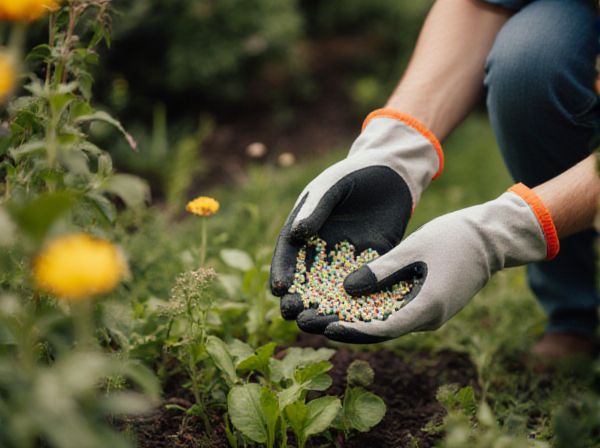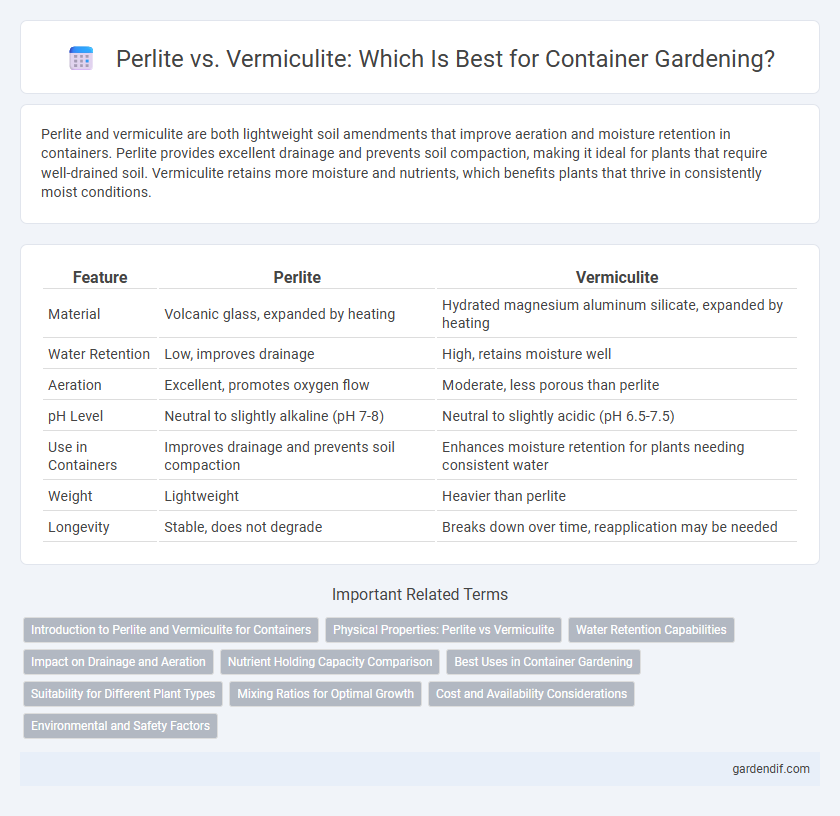
Perlite vs vermiculite in containers Illustration
Perlite and vermiculite are both lightweight soil amendments that improve aeration and moisture retention in containers. Perlite provides excellent drainage and prevents soil compaction, making it ideal for plants that require well-drained soil. Vermiculite retains more moisture and nutrients, which benefits plants that thrive in consistently moist conditions.
Table of Comparison
| Feature | Perlite | Vermiculite |
|---|---|---|
| Material | Volcanic glass, expanded by heating | Hydrated magnesium aluminum silicate, expanded by heating |
| Water Retention | Low, improves drainage | High, retains moisture well |
| Aeration | Excellent, promotes oxygen flow | Moderate, less porous than perlite |
| pH Level | Neutral to slightly alkaline (pH 7-8) | Neutral to slightly acidic (pH 6.5-7.5) |
| Use in Containers | Improves drainage and prevents soil compaction | Enhances moisture retention for plants needing consistent water |
| Weight | Lightweight | Heavier than perlite |
| Longevity | Stable, does not degrade | Breaks down over time, reapplication may be needed |
Introduction to Perlite and Vermiculite for Containers
Perlite is a lightweight, volcanic glass that expands when heated, providing excellent aeration and drainage in container gardening. Vermiculite is a hydrated mineral that improves water retention and nutrient absorption, making it ideal for moisture-loving plants in pots. Both materials enhance soil structure but serve different roles: perlite promotes airflow and prevents compaction, while vermiculite helps maintain consistent moisture levels.
Physical Properties: Perlite vs Vermiculite
Perlite has a lightweight, porous structure that promotes excellent aeration and drainage in containers, preventing waterlogging and root rot. Vermiculite, with its layered, spongy texture, retains moisture effectively while providing moderate aeration, making it ideal for water-sensitive plants. The choice between perlite and vermiculite depends on the container's moisture retention needs and the specific physical properties required for optimal plant growth.
Water Retention Capabilities
Perlite offers excellent aeration and moderate water retention, making it ideal for plants that require well-drained soil. Vermiculite has superior water retention abilities, absorbing and holding moisture efficiently to provide consistent hydration. Choosing between perlite and vermiculite depends on the specific moisture needs of container plants and the desired soil drainage.
Impact on Drainage and Aeration
Perlite improves container drainage by creating large air pockets that prevent soil compaction and promote rapid water movement, enhancing root oxygen availability. Vermiculite retains more moisture due to its fine particles while still providing moderate aeration, making it suitable for plants requiring consistent moisture. Choosing perlite in containers results in better drainage and aeration for plants prone to root rot, whereas vermiculite supports moisture retention with balanced aeration for delicate seedlings.
Nutrient Holding Capacity Comparison
Perlite offers excellent aeration and drainage but has a low nutrient holding capacity, making it ideal for plants requiring well-drained soil. Vermiculite retains moisture and nutrients effectively, providing better nutrient holding capacity compared to perlite, which supports long-term plant growth. Choosing vermiculite enhances nutrient availability in containers, while perlite benefits soils needing superior oxygen flow.
Best Uses in Container Gardening
Perlite provides excellent aeration and drainage, making it ideal for container gardening with succulents, cacti, and other plants that require well-drained soil. Vermiculite retains moisture and nutrients effectively, benefiting container plants that thrive in consistently moist conditions such as ferns and begonias. Using a mix of perlite and vermiculite can optimize both moisture retention and aeration, promoting healthy root growth in diverse container gardens.
Suitability for Different Plant Types
Perlite excels in containers for succulents and cacti due to its excellent drainage and aeration properties, preventing root rot in drought-tolerant plants. Vermiculite retains more moisture and nutrients, making it ideal for moisture-loving plants such as ferns and seedlings that require consistent hydration. Choosing between perlite and vermiculite in container gardening depends on the specific water and air needs of the plant species being grown.
Mixing Ratios for Optimal Growth
Perlite and vermiculite both enhance container soil aeration and moisture retention but require different mixing ratios for optimal growth. Use a 1:1 ratio of perlite to potting mix for improved drainage and root oxygenation, while vermiculite is best at a 1:2 ratio to retain moisture and nutrients more effectively. Balancing these ratios based on plant type and water needs maximizes container growth and root development.
Cost and Availability Considerations
Perlite is more cost-effective and widely available than vermiculite, making it a preferred choice for large-scale container gardening and commercial use. Vermiculite tends to be pricier and less abundant, though it offers superior water retention, which may justify the investment for specific container gardening needs. Budget-conscious growers often select perlite to maintain affordability without compromising aeration and drainage in containers.
Environmental and Safety Factors
Perlite and vermiculite differ significantly in their environmental impact and safety profiles when used in containers. Perlite is a naturally occurring volcanic glass that expands when heated, producing a lightweight, sterile medium with minimal chemical reactivity, making it environmentally friendly and safe for use around plants and pets. Vermiculite, a hydrated magnesium aluminum silicate, can sometimes carry trace amounts of asbestos if sourced from contaminated mines, posing potential health risks, although modern commercial vermiculite is typically asbestos-free and widely regarded as safe.
Perlite vs vermiculite in containers Infographic

 gardendif.com
gardendif.com